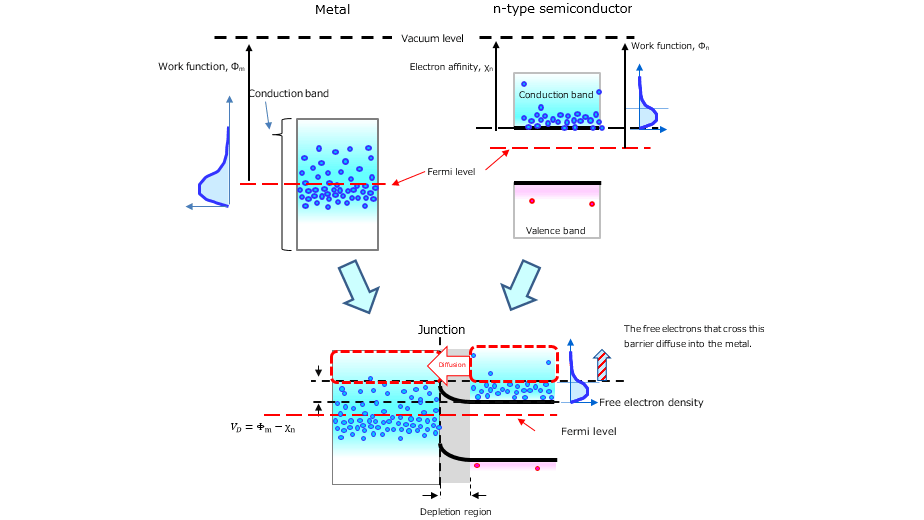- General Top
- SEMICONDUCTOR
- STORAGE
- COMPANY
-
My ToshibaSemicon
- Semiconductor Top
-
ApplicationsAutomotive
Body Electronics
xEV
In-Vehicle Infotainment
Advanced Driver-Assistance Systems (ADAS)
Chassis
IndustrialInfrastructure
BEMS/HEMS
Factory Automation
Commercial Equipment
Consumer/PersonalIoT Equipment
Healthcare
Wearable Device
Mobile
Computer Peripherals
-
ProductsAutomotive Devices
Discrete Semiconductor
Diodes
Transistors
Logic ICs
Analog Devices
Digital Devices
Wireless Devices
※
: Products list (parametric search)
Power SemiconductorsSiC Power Devices
※
: Products list (parametric search)
Isolators/Solid State RelaysPhotocouplers
Digital Isolators
Solid State Relays
Fiber Optic Transmitting Modules
※
: Products list (parametric search)
MOSFETsIGBTs/IEGTsBipolar Transistors※
: Products list (parametric search)
Diodes※
: Products list (parametric search)
MicrocontrollersMotor Driver ICsIntelligent Power ICs※
: Products list (parametric search)
Power Management ICsLinear ICs※
: Products list (parametric search)
General Purpose Logic ICsLinear Image SensorsOther Product ICsOther Product ICs
※
: Products list (parametric search)
-
Design & Development
Design & Development
Innovation Centre
At the Toshiba Innovation Centre we constantly strive to inspire you with our technologies and solutions. Discover how to place us at the heart of your innovations.
-
Knowledge
Knowledge
Highlighted Topics
Further Materials
Other
- Where To Buy
- Part Number & Keyword Search
- Cross Reference Search
- Parametric Search
- Stock Check & Purchase
This webpage doesn't work with Internet Explorer. Please use the latest version of Google Chrome, Microsoft Edge, Mozilla Firefox or Safari.
require 3 characters or more. Search for multiple part numbers fromhere.
The information presented in this cross reference is based on TOSHIBA's selection criteria and should be treated as a suggestion only. Please carefully review the latest versions of all relevant information on the TOSHIBA products, including without limitation data sheets and validate all operating parameters of the TOSHIBA products to ensure that the suggested TOSHIBA products are truly compatible with your design and application.Please note that this cross reference is based on TOSHIBA's estimate of compatibility with other manufacturers' products, based on other manufacturers' published data, at the time the data was collected.TOSHIBA is not responsible for any incorrect or incomplete information. Information is subject to change at any time without notice.
require 3 characters or more.
2-3. Conductivity modulation
In the previous subsections, we have discussed the pn and metal-semiconductor junctions. A pn junction is a bipolar junction because both electrons and holes act as charge carriers whereas a metal-semiconductor junction is a unipolar junction (also called a monopolar junction) because either electrons or holes act as charge carriers.
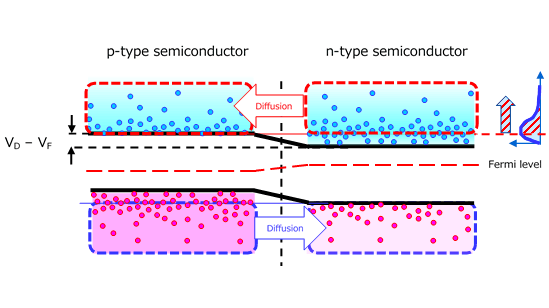

To create a pn junction, a lightly doped n-type (or p-type) semiconductor substrate is heavily doped with boron (B) or other p-type dopant using a diffusion, epitaxial growth, or ion implantation process. Therefore, the lightly doped n-type (or p-type) substrate acts as a series resistor. Note that the conductivity modulation of the pn junction causes its series resistance to decrease.
Typical pn junction diodes consist of heavily doped p-type (p+) and n-type (n+) regions on either side of a lightly doped n (n–) region. Diodes with an extremely lightly doped n– region are called PIN diodes. Typical pn junction diodes have a structure similar to that of PIN diodes although I layers of pn junction diodes are more heavily doped.
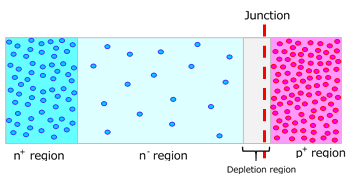
Electrons from a power supply flow into the n– region via the n+ region. To maintain electrical neutrality, holes are injected into the n– region from the p+ region. These electrons and holes recombine and disappear ultimately. Carrier lifetime is defined as the average time required for this recombination. Because both electrons and holes exist in the n– region during this period, it exhibits low resistance as if it were a heavily doped region.
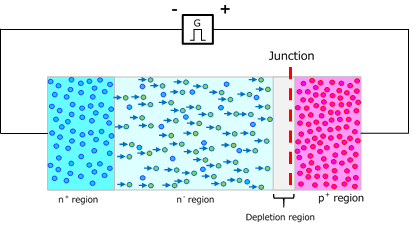
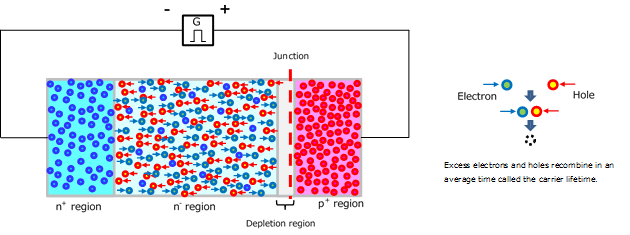
The longer the carrier lifetime, the stronger the conductivity modulation effect, yet at the expense of an increase in reverse recovery time (i.e., the time required for a diode to stop conducting). Toshiba provides a type of diodes with a reduced reverse recovery time (i.e., a reduced carrier lifetime) called fast-recovery diodes (FRDs). The FRD has a shallower forward voltage-vs-forward current curve (i.e., higher forward resistance) than the typical pn junction diode as shown in Figure 2-10.
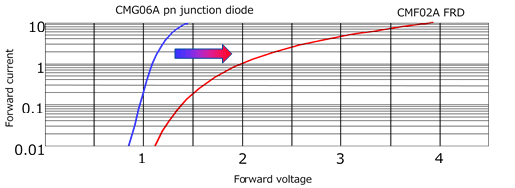
- Prev
- 4/4
Chapter2 Basics of Schottky Barrier Diodes (Basic of Metal-semiconductor junction)
Related information
- Products
Schottky Barrier Diodes - Application Notes
Application Notes - FAQs
Diodes - Parametric Search
Schottky Barrier Diodes - Stock Check & Purchase
Stock Check & Purchase



